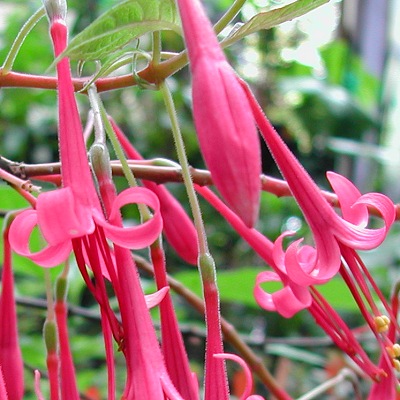Germinating the seeds
Plant your seeds when you receive them for the best germination Getting started -- Use small containers or cups that have drainage holes.
For soil, use a well draining mix. I use a mix of 1 part
coco fiber Fill each container, place a seed or 2 on top, and sprinkle a thin layer of soil on top - just enough to barely cover the seeds, because light helps the seeds germinate. Add water until the soil is evenly moist (not fully saturated). Until the seeds sprout, ensure that the soil surface always stays moist. An easy way maintain moisture is to enclose the pots in a plastic container. Leave it open slightly to allow some fresh air in. You may need to drip a few drops of water on the seeds every day keep them moist. Keep the pots at about 65-77 degrees F (18-25°C). A little cooler at night is ok, but avoid letting them get above
80°F (27°C). I recommend placing a
minimum/maximum thermometer Keep them in bright light out of direct sun. An LED or fluorescent bulb kept 4 inches (10 cm) away provides the right amount of light (See: "Growing indoors with LED lights"). The seeds tend to begin sprouting in about 4 to 6 weeks, but may take up to 8 weeks to start, especially at cooler temperatures. Give your seedlings bright light, but avoid direct sunlight while they are small. I recommend growing them indoors for at least 3 months. Fertilizing -- The first 3 months, feed weekly with a small amount of dilute (1/8 strength) liquid fertilizer. Hydroponic fertilizer is ideal for this, because it is easily absorbed and contains all essential nutrients. After 3 months, you may switch to a granular fertilizer, feeding at half the dosage on the package. Or continue feeding weekly with some dilute liquid fertilizer. Growing onward... Watering - This Fuchsia likes evenly moist soil, but it shouldn't be perpetually soggy either. Never let the pots dry out, but don't let them sit in a tray of water either. If your tap water is very high in minerals (or "hard") i recommend using bottled spring water or rain water. Climate -- It thrives when temperatures are mild during the day and cool at night. The plant might get stressed if temperatures regularly get above 85° F (29°C), and nights are above 65 degrees F (18 C). In warmer conditions, give the plants afternoon shade, and keep the pot shaded. The first 2 years, i recommend keeping it above 40°F (4°C). Mature plants can probably only survive a light frost (26°F/-3°C), but it's best to protect them from freezing temperatures. Over about 40% humidity is best. Transplanting -- When your plants are 2-3 months old, you may gently transfer them to a larger pot. Water the soil first, and avoid letting the soil ball break apart, which can damage the roots. After transplanting, give no sun or liquid fertilizer the first week. Dormancy - The plant tends to drop most or all of its leaves in winter, if temperatures are cool. Be careful not to overwater during this time. Pests to watch for - Watch for any bugs that typically affect your other plants. If you have any questions, feel free to contact me. Have fun growing them! - Jeff Strange Wonderful Things
|
|||||||||


